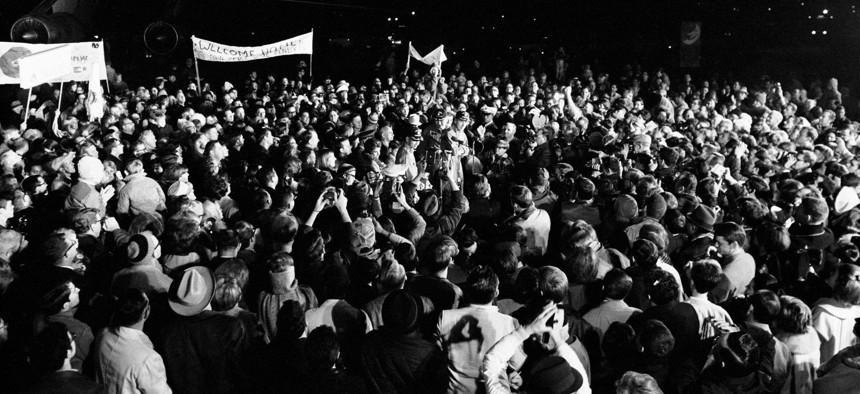
NASA file photo
Apollo 8 Helped America Survive 1968—a Year Remarkably Similar to 2018
In a country so polarized about so much, no one seemed to disagree: Apollo 8 had done something important and profound.
Few years were more terrible to America than 1968.
Assassins killed Martin Luther King, Jr. and Robert Kennedy. Protests by anti-war demonstrators, students, and counter-culture activists resulted in violence at the Democratic National Convention in Chicago, on college campuses, and in the streets. The Soviet Union stood as our great existential enemy. Trust in government cratered as much of the public came to believe that politicians weren’t telling the truth about our prospects in Vietnam.
At the Summer Olympics in Mexico City, two black American sprinters, Tommie Smith and John Carlos, protested against the racism they saw in their own country. Outside the Miss America pageant, at least a hundred women railed against the event, which they deemed exploitative. Young people called hippies threatened to overturn the social order.
As the year unfolded, America only grew more bitterly divided. To many, it felt like the country was coming apart at the seams.
How very familiar it all looks fifty years later.
In 2018, public violence—school shootings, bombings, and acts of terror—seem a weekly occurrence. The Soviet Union has again become a primary threat. Trust in government can be summed up by a single number—18—the percentage of Americans who approve of how Congress does its job.
Black athletes now kneel rather than raise their fists, but their complaint—racism in America—is the same. The #Metoo movement has exploded in revolt against the exploitation of women by powerful men. There are new young people—Antifa, Black Lives Matter, masked campus protesters—shouting their disgust with society and their intention to change it. Everyone’s nerves, it seems, are raw and raging. It feels again like we are coming apart.

Optimists argue that since America survived 1968, she can survive 2018. But there was at least one big difference between the two years. In 1968, America had Apollo 8.
Originally intended as a low Earth orbital flight, Apollo 8’s mission was changed suddenly in the summer of 1968. Despite having just four months to plan (not the usual 12 to 18 typical for a spaceflight), NASA decided to send Apollo 8 and its crew—Frank Borman, Jim Lovell, and Bill Anders—to the Moon.
NASA wasn’t ready to send men to the Moon. The Saturn V rocket, the only one powerful enough for such a mission, had been tested only twice, both times unmanned, and had experienced serious failures the second time out. Since Apollo 8 would only be orbiting the Moon—not landing—it wouldn’t carry a lunar lander, which also could serve as a backup engine. That meant if the spacecraft’s single engine failed or malfunctioned at the Moon, Apollo 8 could smash into the lunar surface or be stranded in lunar orbit or fly off toward the Sun. And there were myriad other risks, any of which might have doomed the flight.
And yet, if Apollo 8 could make it to the Moon—on Christmas, no less—the mission might perform miracles. It could keep the Apollo program moving (trouble with the lunar lander had threatened to stall progress); help fulfill President Kennedy’s promise to the nation to land men on the Moon by the end of the decade; and deal a devastating blow to the Soviets in the space race.
It was true, as NASA chief James E. Webb warned, that if Borman, Lovell, and Anders died in lunar orbit, no one would ever look at the Moon the same way again. And the same was true of Christmas.

On the first day of the six-day journey, the crew of Apollo 8 became the first humans to see Earth as a whole sphere. At the Moon, Anders snapped one of the most famous and influential photographs of all time—“Earthrise”—that showed a brilliant blue Earth rising over a gray and lifeless lunar surface, all set against the black infinity of space. The astronauts read the first lines from the Book of Genesis during a Christmas Eve broadcast heard by more than a quarter of the world’s population. When the spacecraft left lunar orbit, Lovell radioed to Houston: “Please be informed—there is a Santa Claus.”
Something changed in America after Apollo 8 splashed down safely on December 27, 1968. In a country so polarized about so much, it seemed no one disagreed about Apollo 8. Blacks and whites, hippies and octogenarians, rich and poor, urban and rural, Democrats and Republicans, all seemed to agree: Apollo 8 had done something important and profound, something mankind had yearned to do for millennia. When people spoke about the mission, they didn’t say NASA did it or even that Borman, Lovell and Anders did it. Most often, they said, “We did it.”
We could use another Apollo 8 for our time.
Perhaps it might occur again in space, in the form of another manned mission to the Moon or even a landing on Mars. Perhaps we might find it in a scientist’s cure for cancer or in a researcher’s first contact with intelligent extraterrestrial life. Or we might never see it coming, only to find it before us one day. But one thing seems certain: if we are to have an Apollo 8 for our time—for any time—we must continue to believe that we are capable of something magnificent, even something impossible. The kind of thing that can only happen if we are all in it together.
Learn how to write for Quartz Ideas. We welcome your comments at ideas@qz.com.






